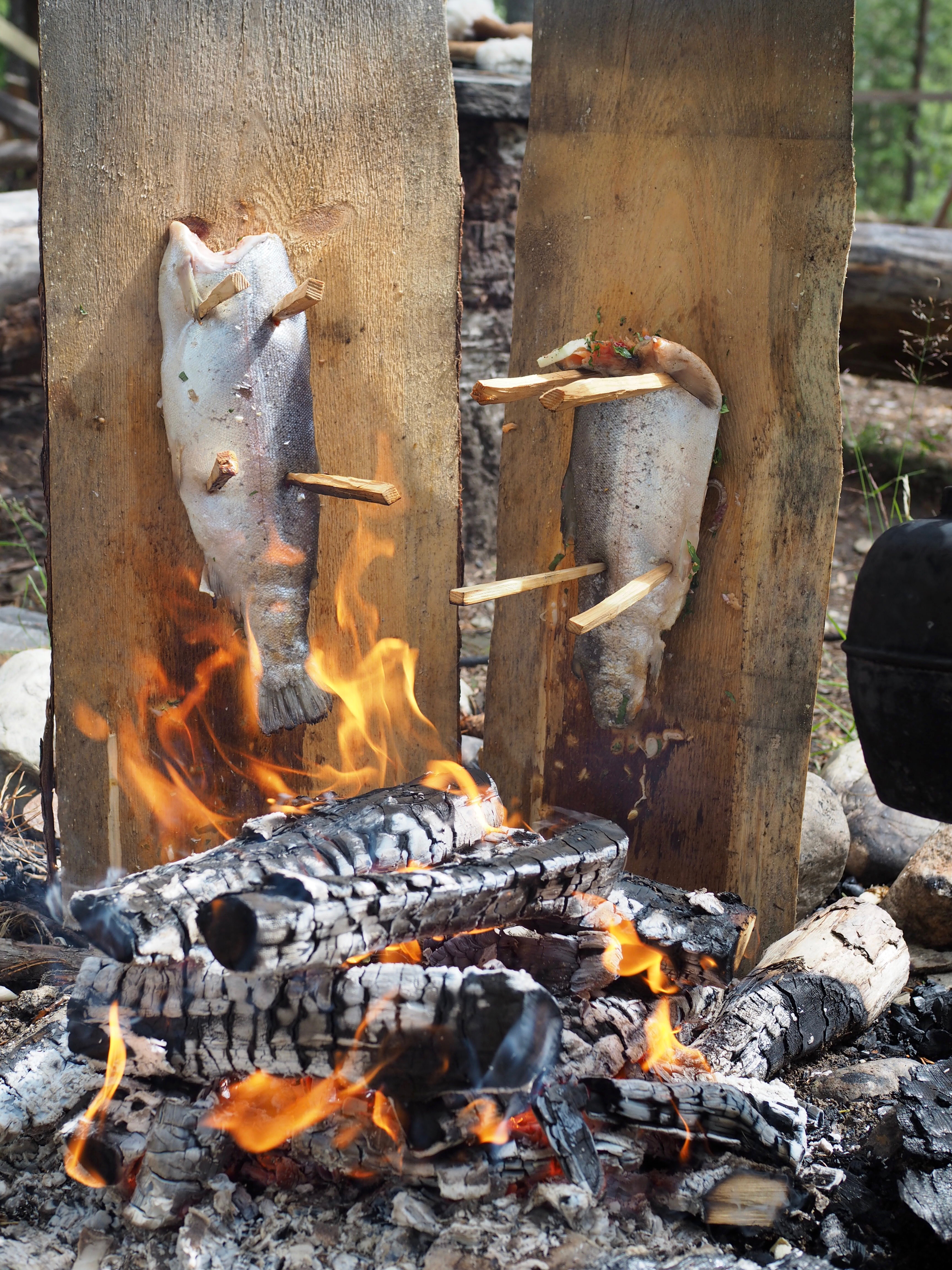
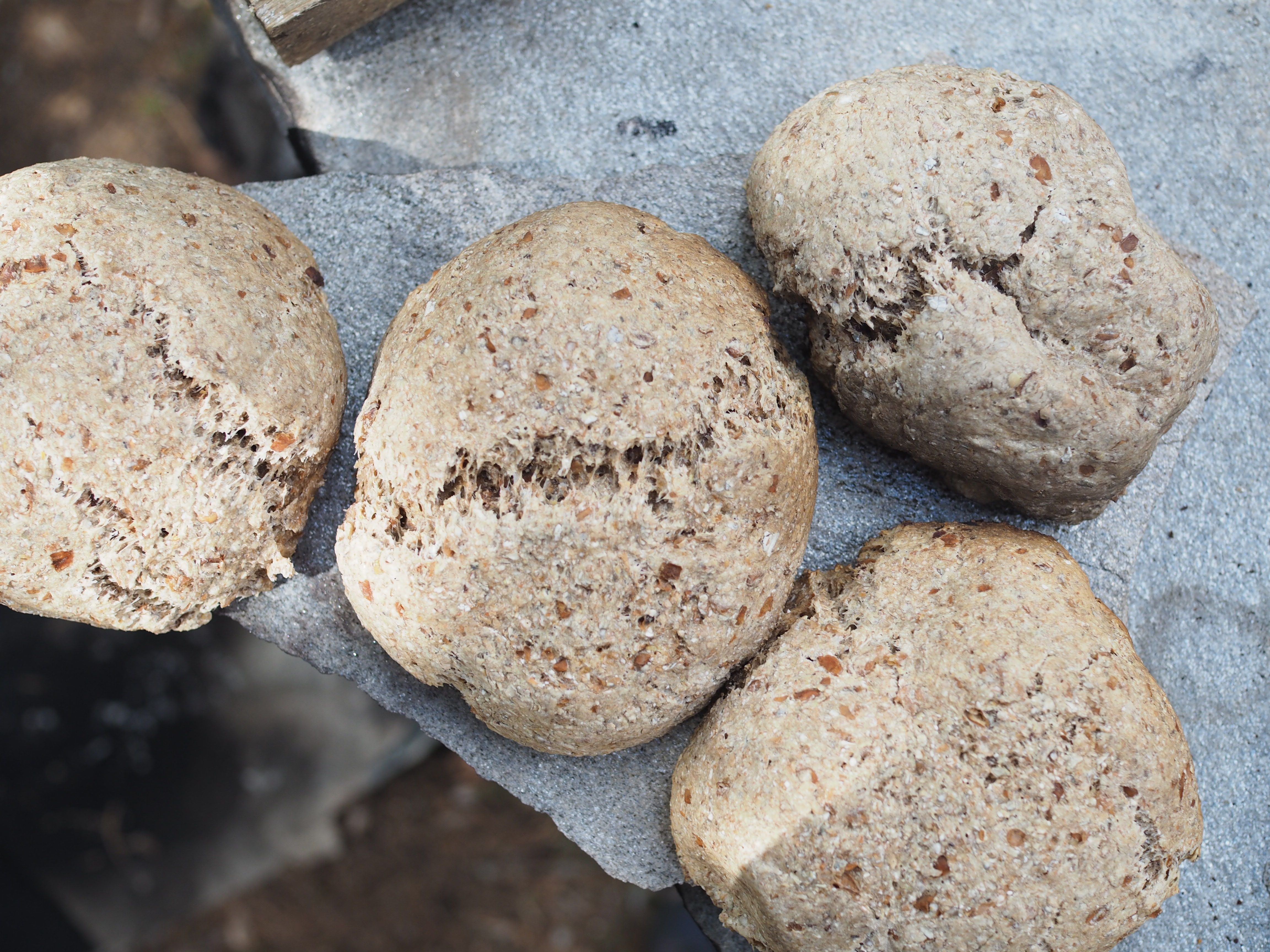
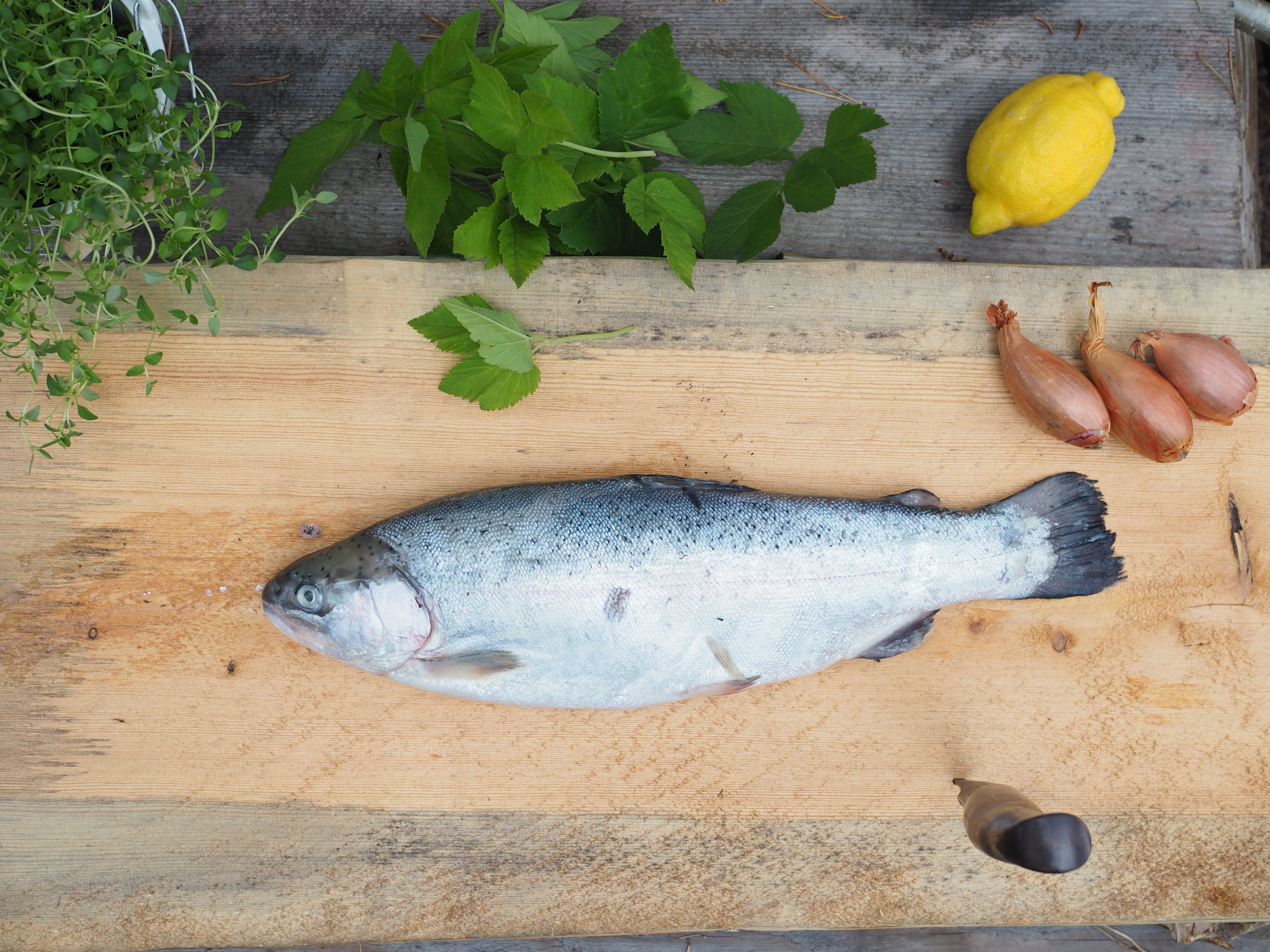 The woods, blending well into the deep valley, are welcoming on this day. Edged against the great river, a short distance from the main road, and yet well hidden, lies the Medieval Forest. An emerging area dedicated to the preservation of history, culture, and traditional skills. A way to step back into time, learn authentic crafting and become more aware of nature and personal strength.
The woods, blending well into the deep valley, are welcoming on this day. Edged against the great river, a short distance from the main road, and yet well hidden, lies the Medieval Forest. An emerging area dedicated to the preservation of history, culture, and traditional skills. A way to step back into time, learn authentic crafting and become more aware of nature and personal strength.
It is here that I meet up with Kjell and Maj-Lis for a glimpse inside the eating habits of the Vikings. The husband and wife team are passionate about their country’s history and the area of Numedal. Every year, during July, they, and other enthusiasts, put on a week-long festival featuring local music, courses on textiles, leather, blacksmithing, archery (to name a few) and other festivities centered around the Middle Ages / Viking Age. The week’s festivities held in Stave churches and historical buildings, among other places, create an atmosphere true to Norway’s history for all ages and all types of interests. It’s an opportunity to step back into time – and even ride in a copy of a Viking ship from 850AD.
The valley, known as Numedal, is a glimpse into life during the Middle Ages. A place to experience how Norwegians once lived. Today, Numedal has named itself the Medieval Valley of Norway (Middelalderdalen). They can safely make such a proclamation because within the valley lies the largest remaining collection of houses and buildings older than 1537 AD. In Rollag, Nore og Uvdal municipalities, there are between 50-60 buildings including 4 stave churches, dating back to the 1100s. The predominance of so many medieval buildings still intact may be due, in part, to the wealth local people gained from the extraction of iron. They could then afford such high quality materials and craftsmen to build enduring structures. The valley has also acted as a pathway and crossroads for trading between the east and west for as far back as one could imagine. Knowledge, culture, religious beliefs and other outside influences most likely came through this area because of this important pathway. It also offered locals a way to barter and trade for what they could not produce.
And so here we are today, meeting at a crossroads, to delve into Norway’s past. Kjell starts a fire in-between the stone walls of the hand built oven. The dough has finished rising and a locally-caught trout lies on a wooden plank near the fire pit. We are making a small feast of plankefisk (plank fish) and rugbrød (rye bread with barley grains). Kjell is also showing me a fun way to cook eggs over an open fire.
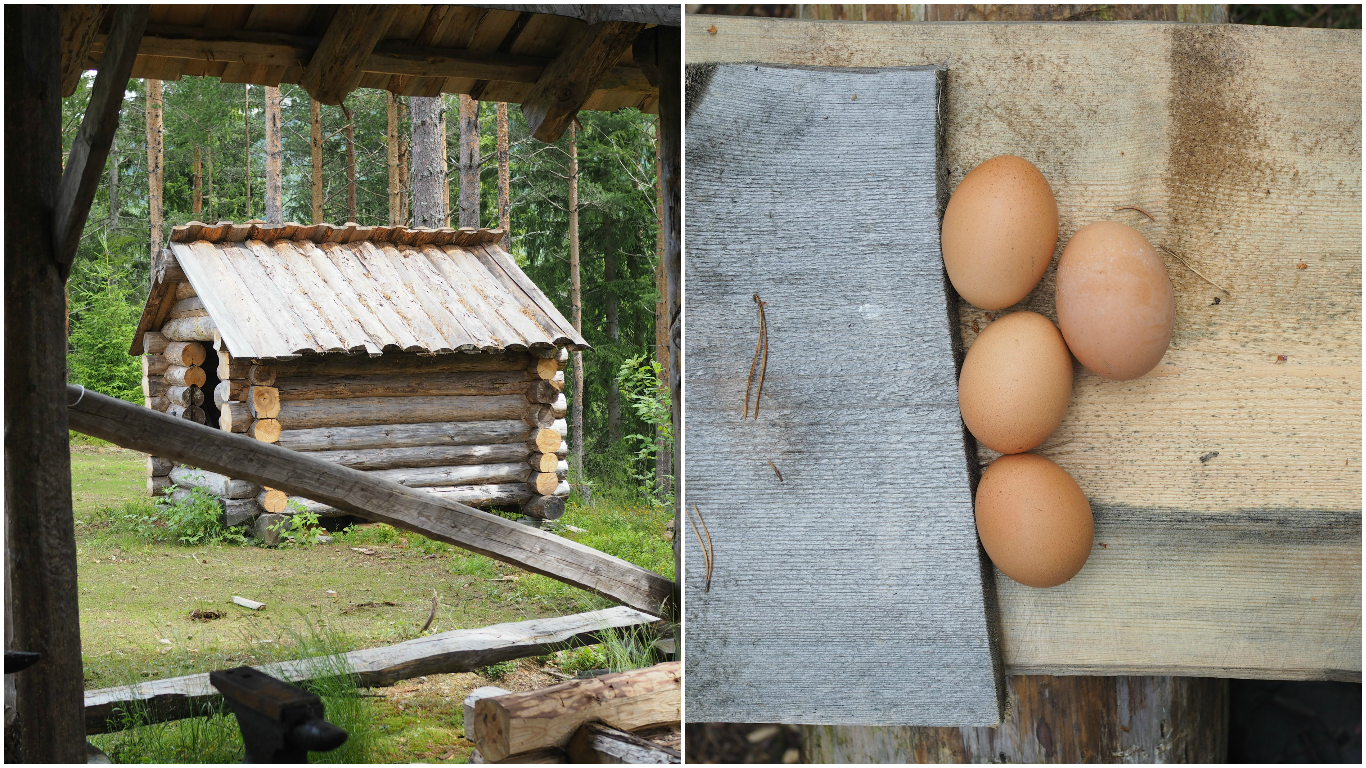

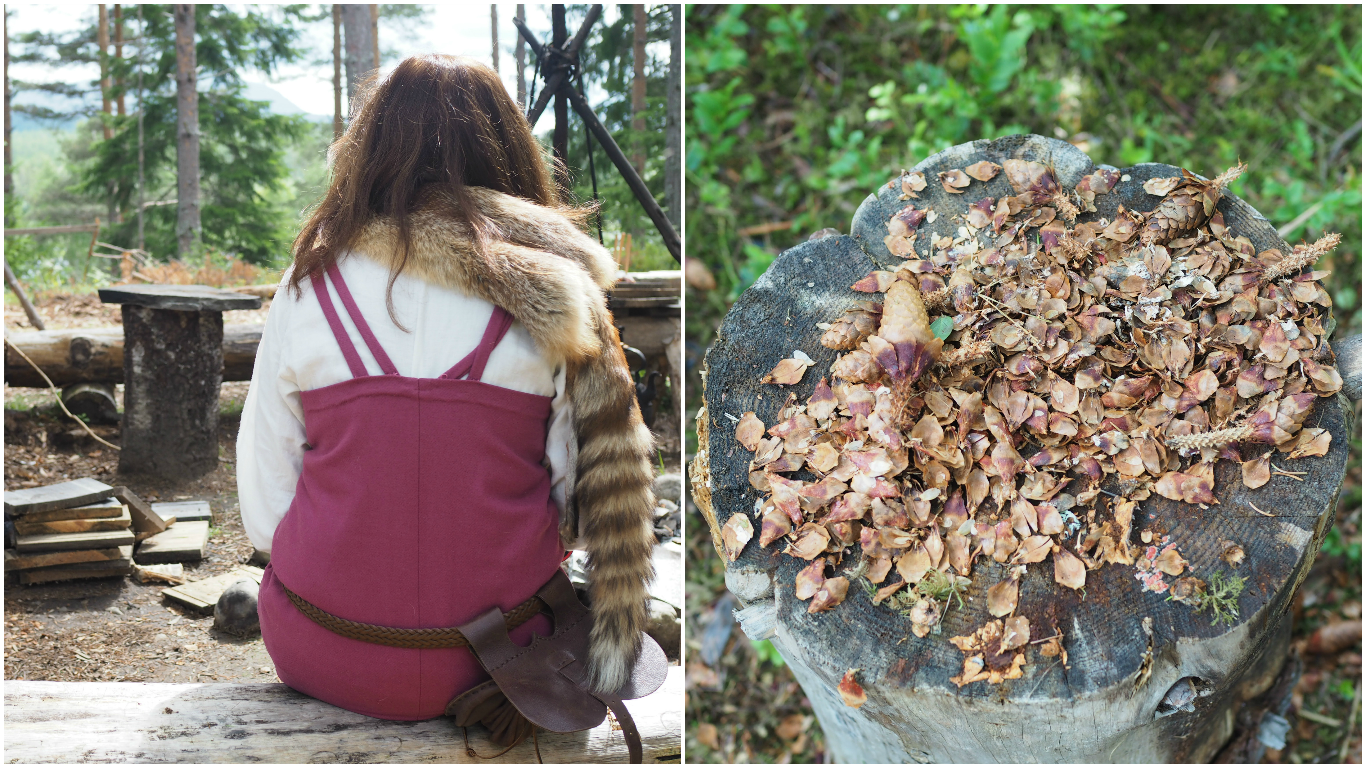 Using his trusty knife, Kjell cuts into the wood planks, making four distinct small holes on each where the fish will be secured. He cuts and cleans the fish and cuts it in half. Using herbs and shallots, known to be used by the Vikings, he generously covers each flesh and adds salt, and for taste, some lemon – although this addition may or may not be quite as authentic.
Using his trusty knife, Kjell cuts into the wood planks, making four distinct small holes on each where the fish will be secured. He cuts and cleans the fish and cuts it in half. Using herbs and shallots, known to be used by the Vikings, he generously covers each flesh and adds salt, and for taste, some lemon – although this addition may or may not be quite as authentic.
He turns the fish fillets over onto each plank, skin side up, and fastens them with wooden pegs he whittled just before. Secured in place, he takes each plank and places it upright next to the open flames of the fire pit. For 1 hour they will slowly cook. Juices dripping down, skin crisping. The aroma from the smoke and trout captivates the area, making it hard not to fall into a trance of fascination as you stare into the glowing flames surrounded by a wild and green nature. Slow cooking means patience and, luckily, we can divert our attention to attend to the baking of the bread in the meantime.
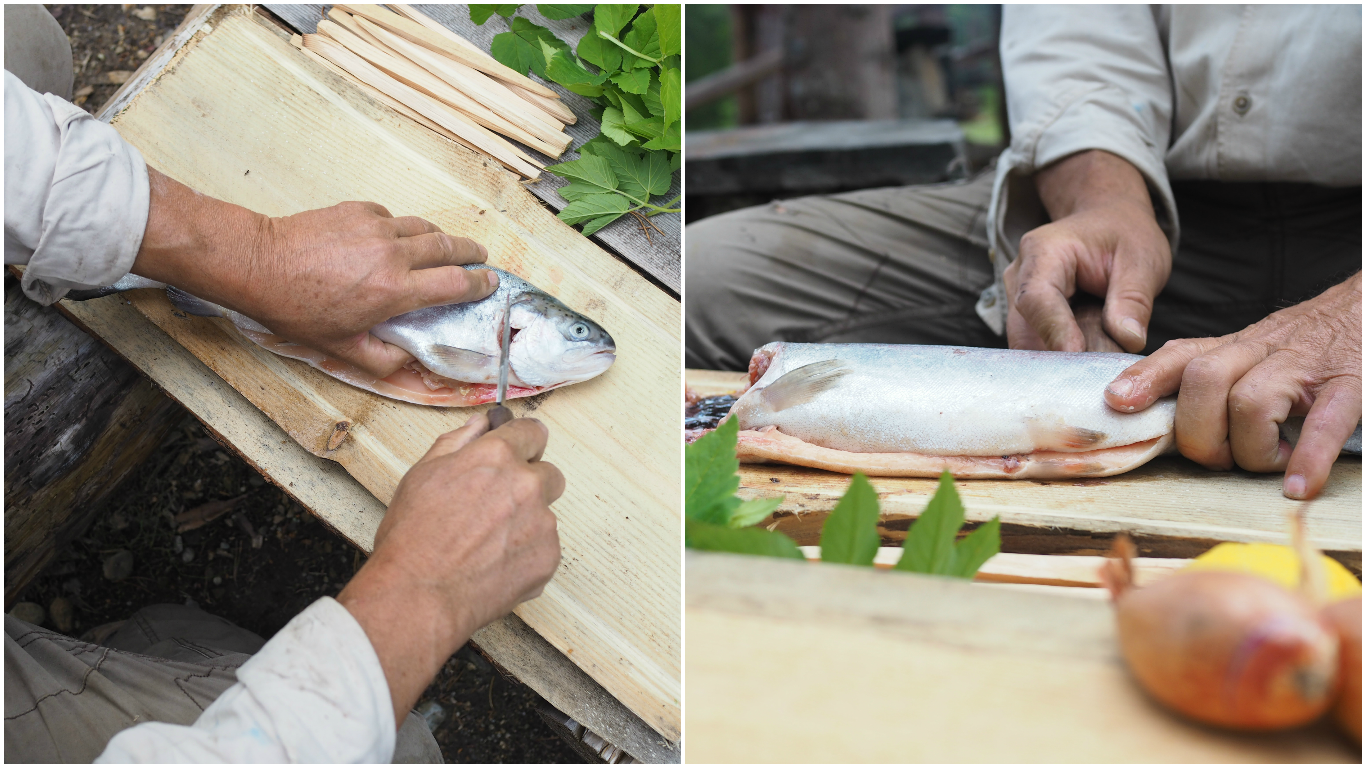
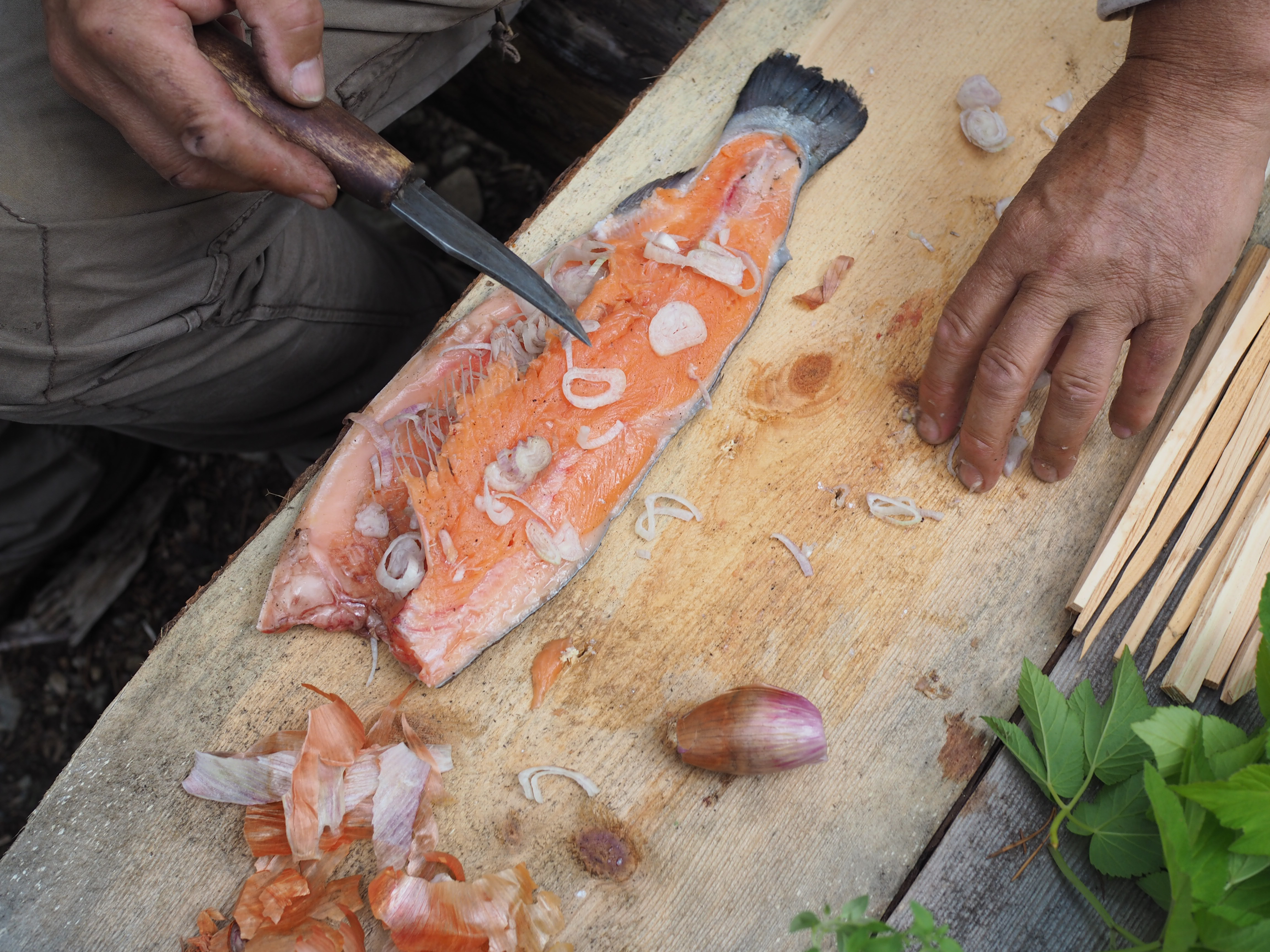
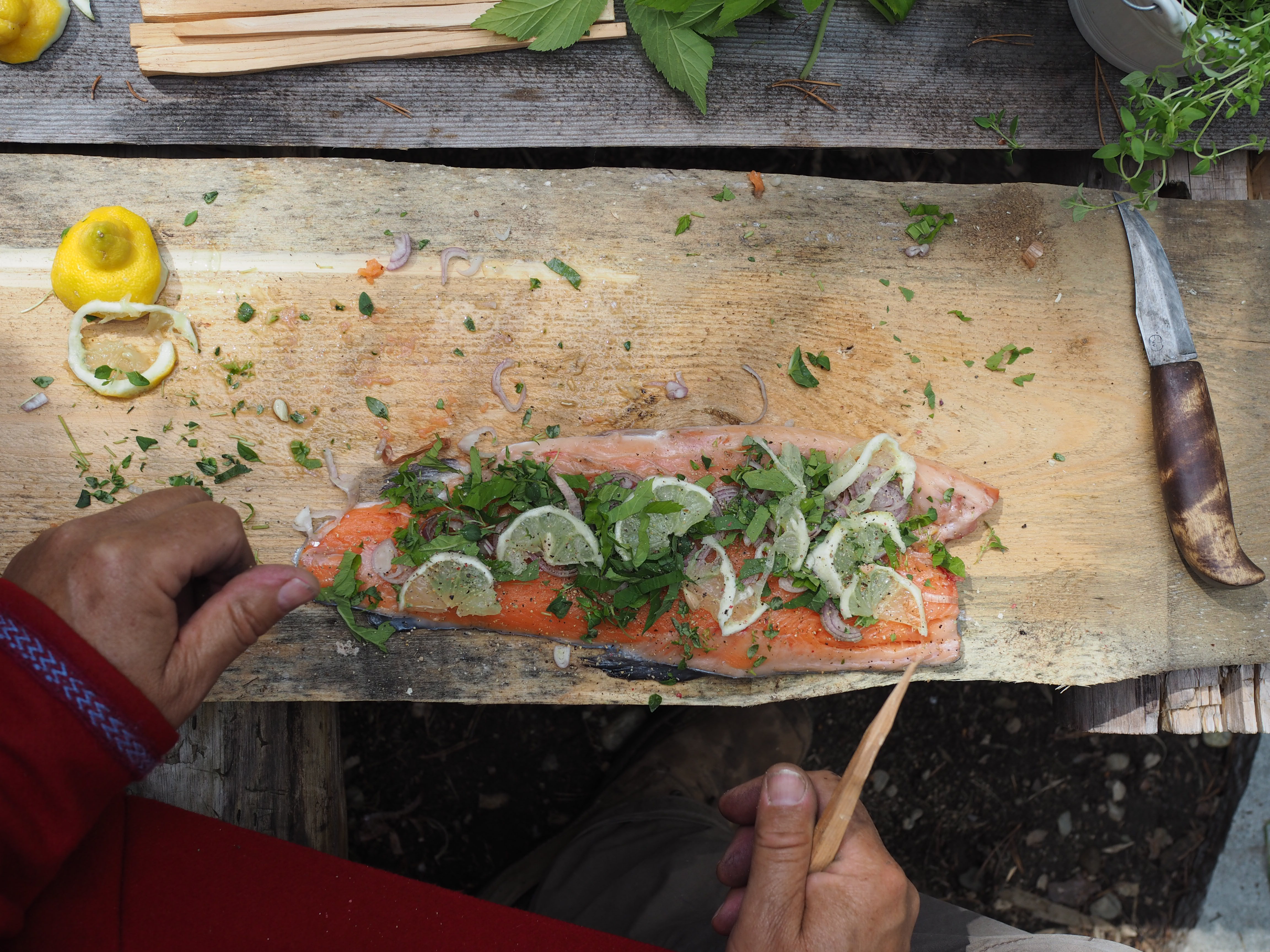
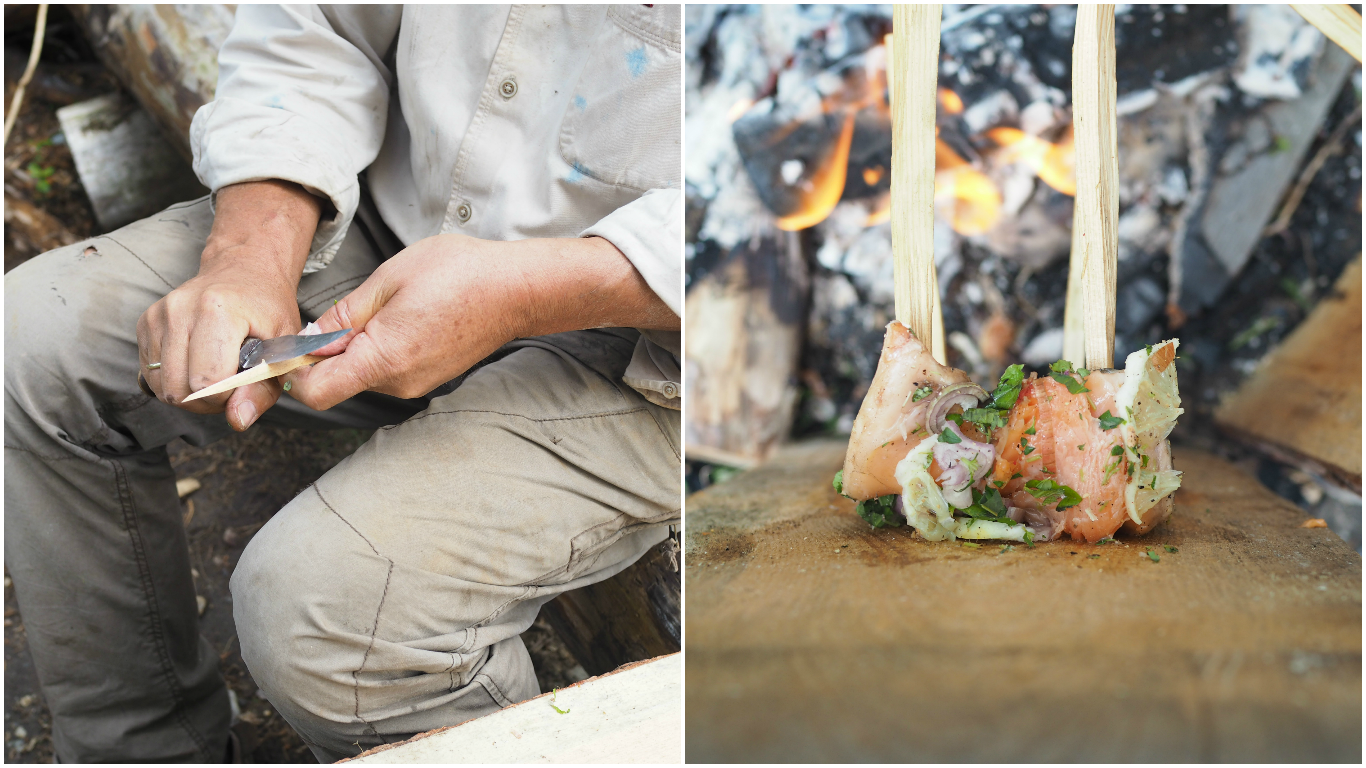
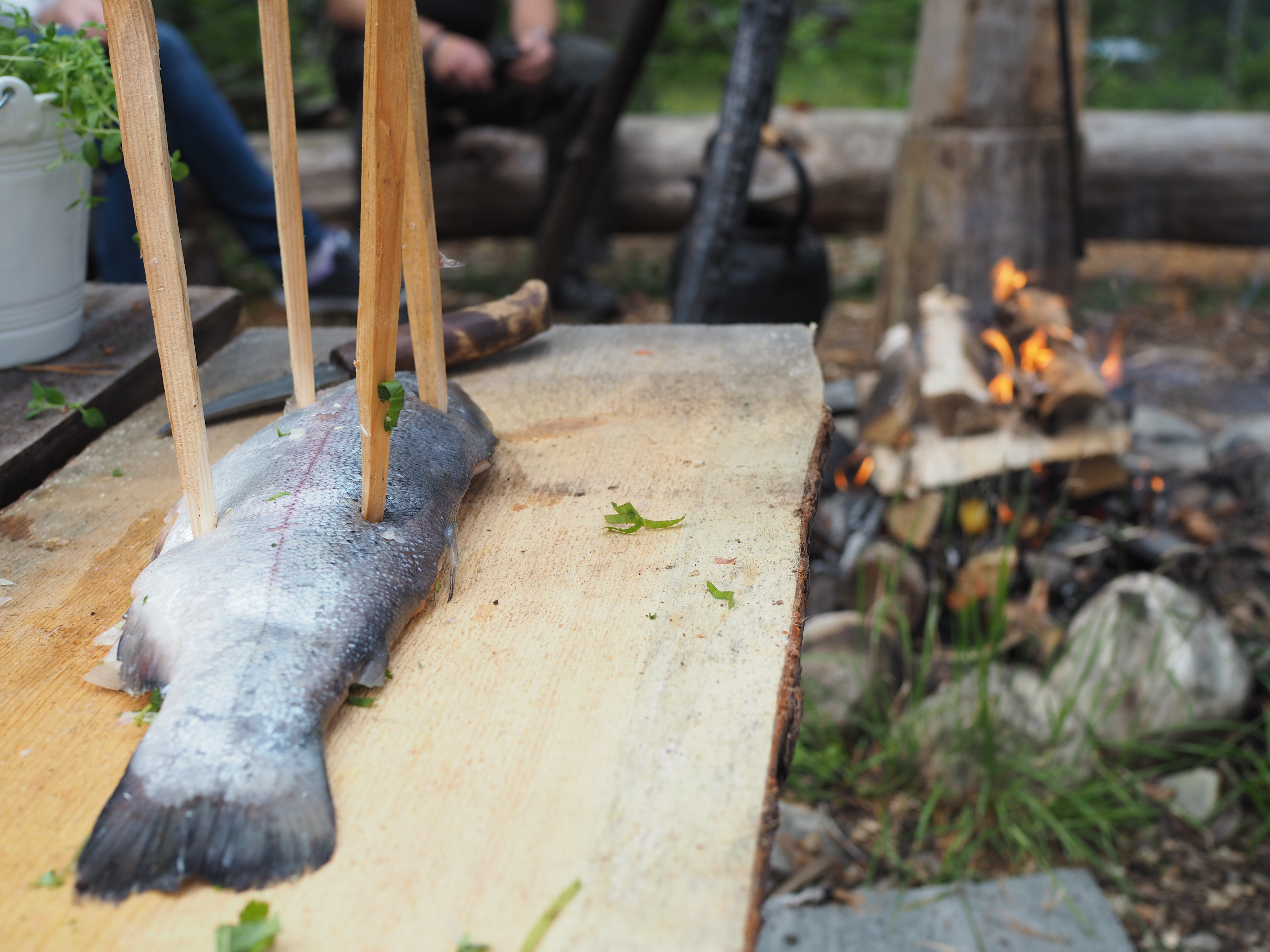 The dough is ready. The stone oven is hot.
The dough is ready. The stone oven is hot.
The recipe comes from the cookbook, An Early Meal, which features the food culture of the Viking Age in Scandinavia. This was my contribution to our small feast. Kjell provided me with the recipe and I spent the day prior preparing the starter for the dough and soaking the barley before blending it all together to let it rise. For the barley, I visited our local bakery, Veggli Bakeri, and requested some to which they happily spared a handful.
This particular recipes stems from Lejre, Denmark where an oven was found filled with rye. Ovens were quite uncommon in the Viking Age, and considered exclusive. This finding could be indicative of a leavened bread, even though finds of this nature are scarce. This recipe reconstruction focuses on fermentation and flour. Fermenting would have been done by leaving some dough in a trough to collect yeast microbes in the air, or by using the remains of an earlier batch or even still adding some barm, or yeast, from a recent beer brew. By adding a small amount of baker’s yeast in this recipe, the result is similar to that when using the yeast saved from brewing. And it would be adduced that, during this time period, each bread would contain two or more types of cereal, therefore, wheat, rye and barley is used in this recipe. The recipe also calls to smoke the barley malt, as it is most likely that seeds and flour would have been kept in a somewhat smokey environment, however, I did not use this technique in lieu of time.
With the front stones from the oven removed, Kjell carefully sets four rolls inside and places the stones back over the fire and bread. A primitive and simple oven which reminds me of a time before all of our kitchen gadgets and technology. A time when our hands not only created the meal, but also the materials in which we cooked the meal in. And the pride that comes from being a part of the entire process. To create and share in the midst of family and friends is a one of life’s greatest pleasures. And here we are, stepping back into time, and yet very much remaining in the present.

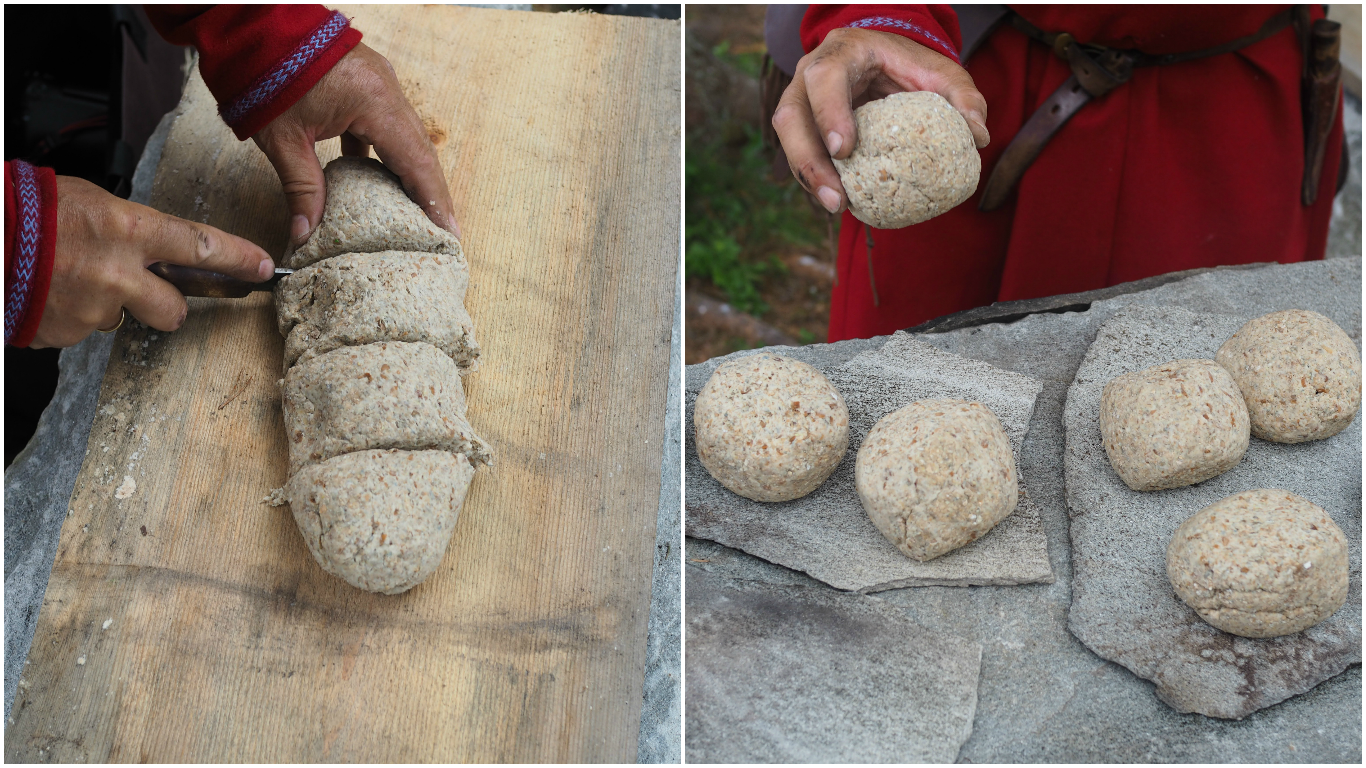
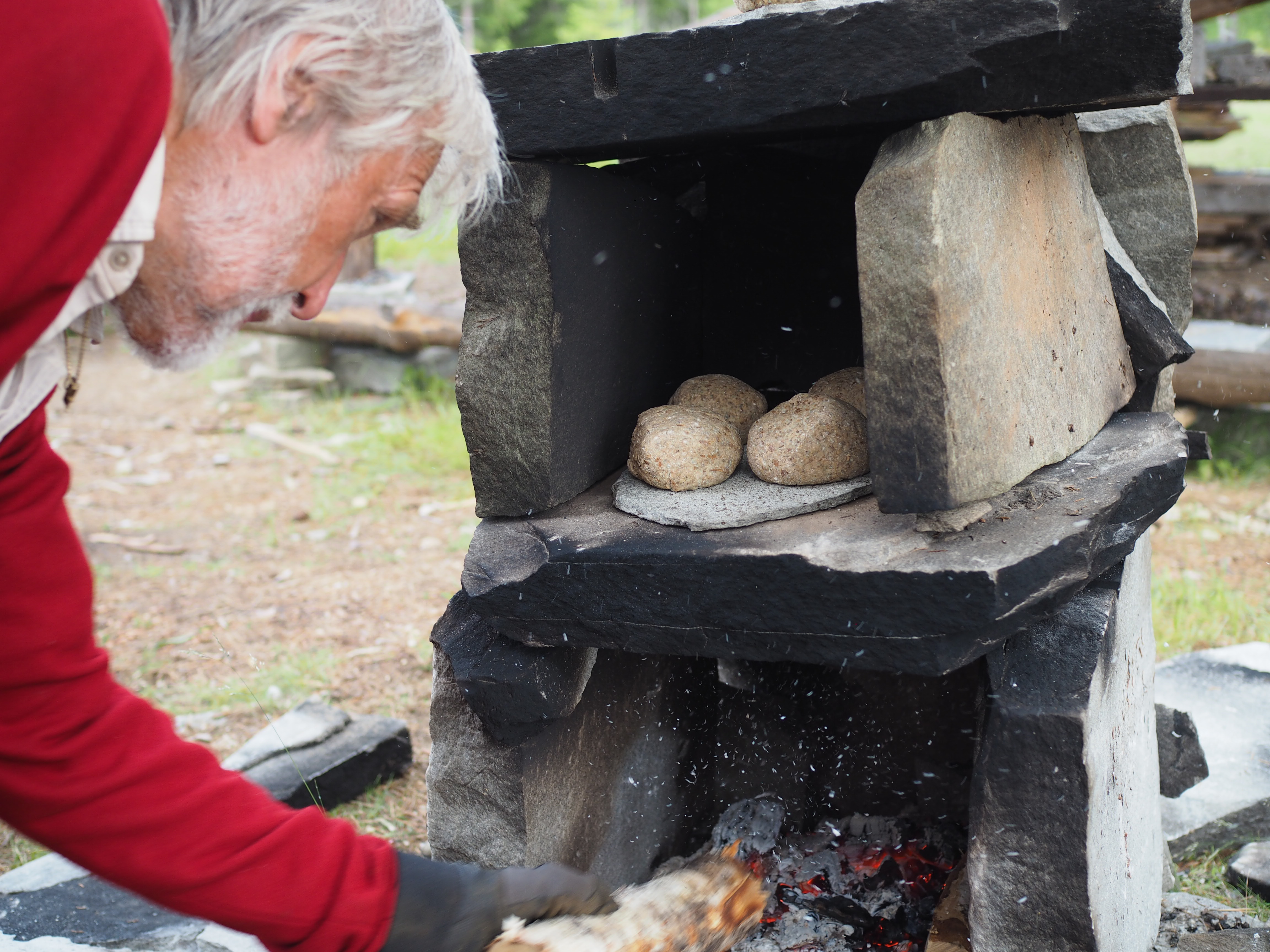
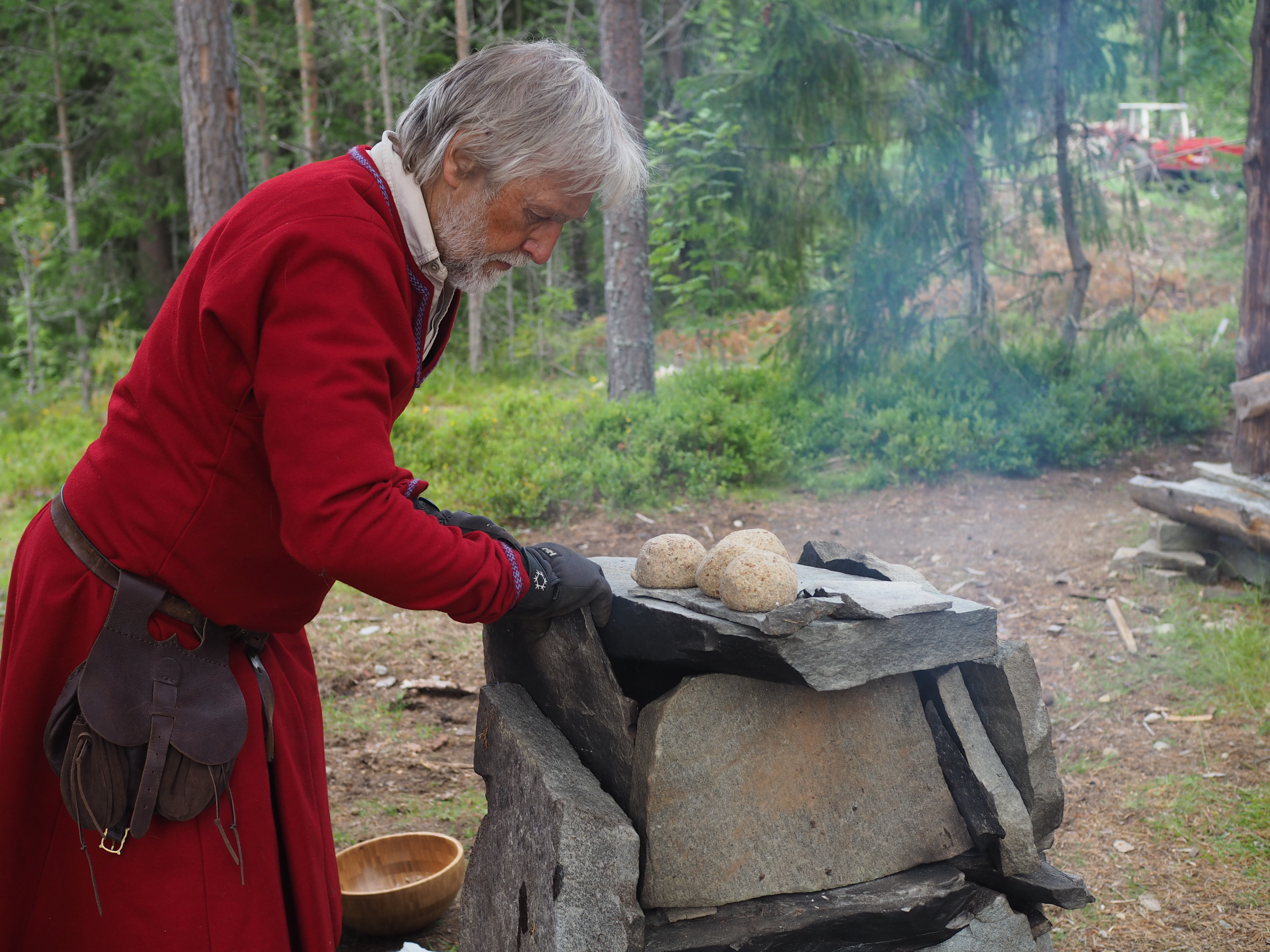
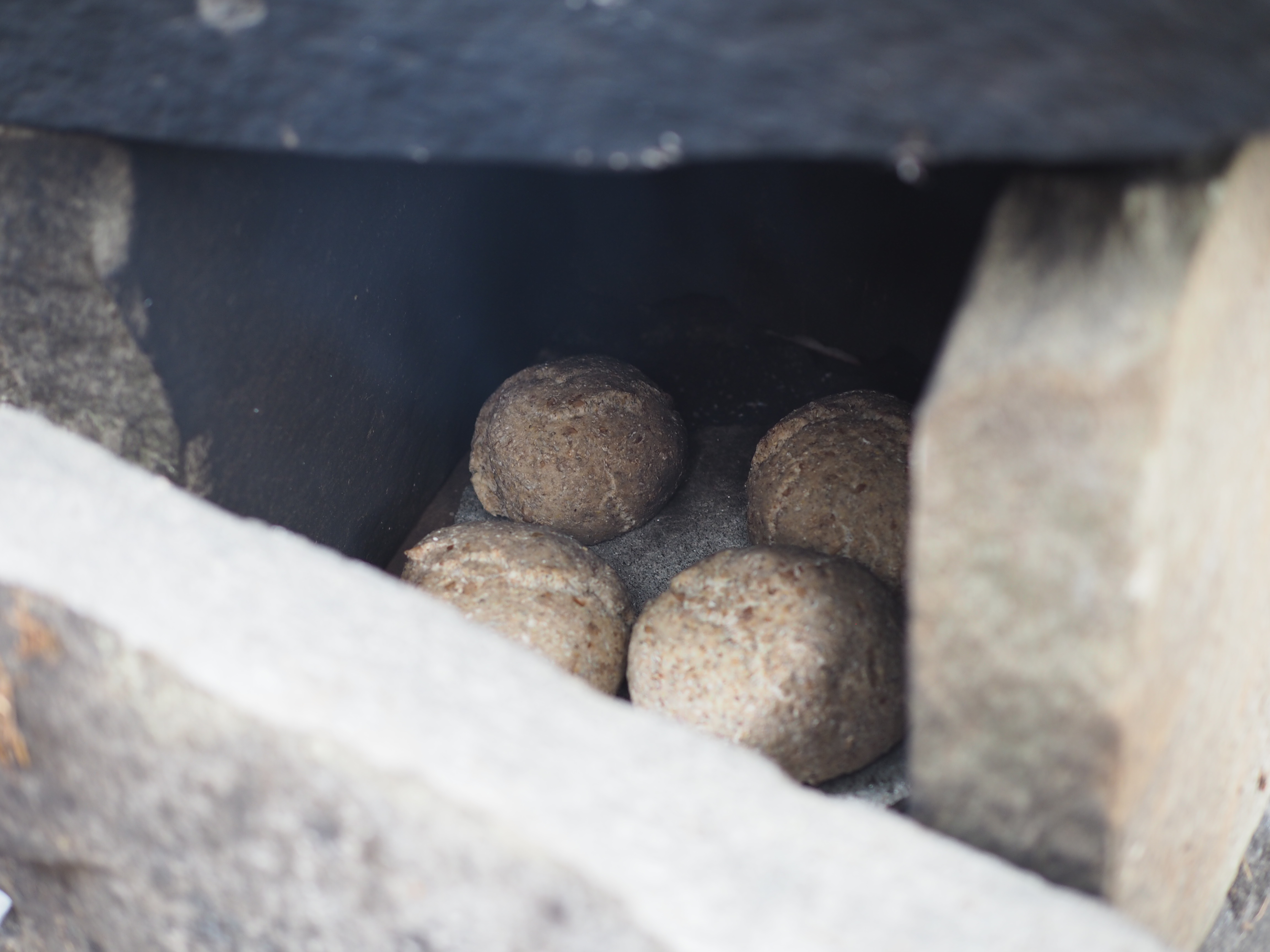
The trout is perfectly cooked, the bread is dense and soft and the eggs have a smokiness which is surprisingly delightful. It’s time to feast!
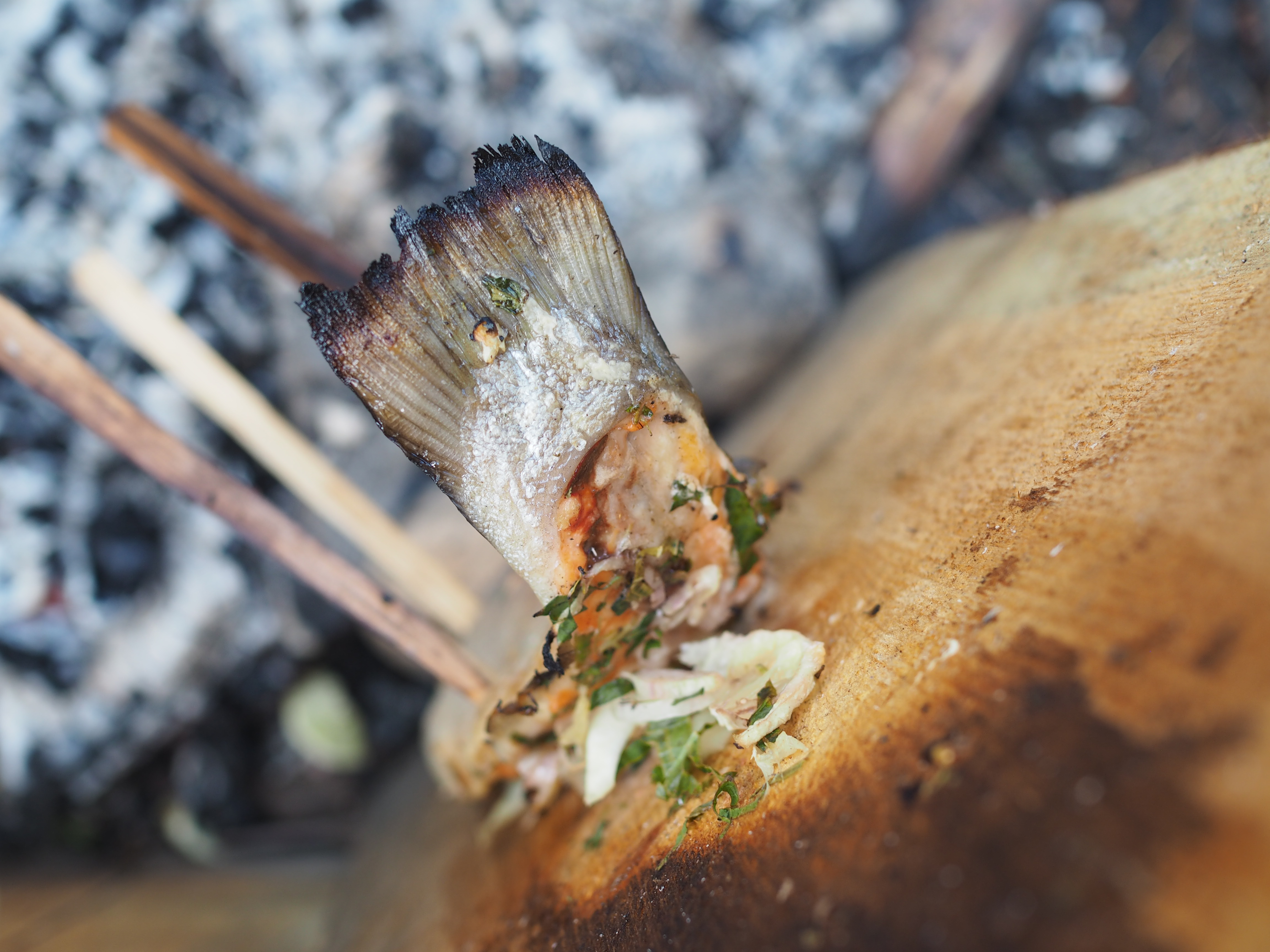
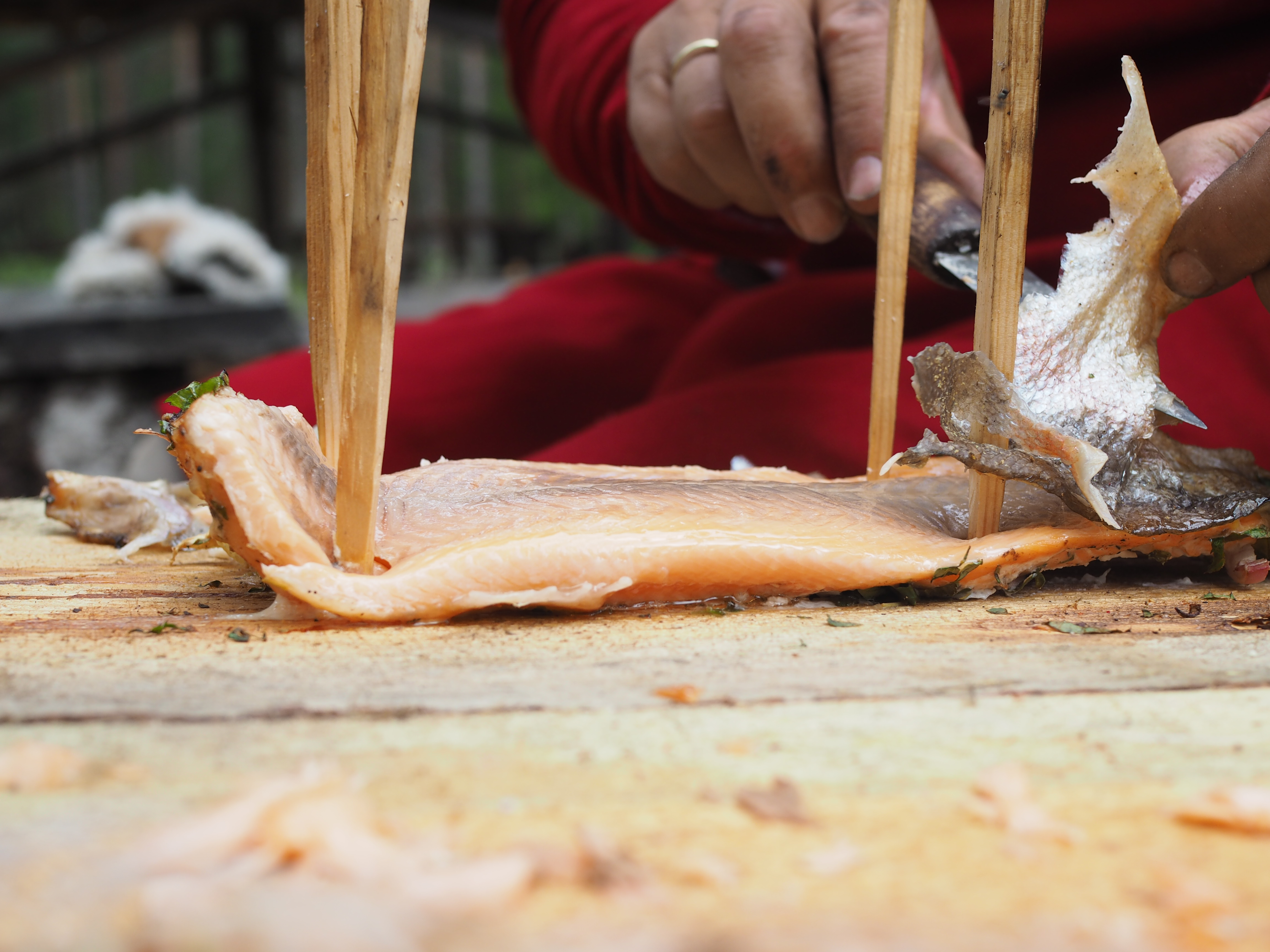
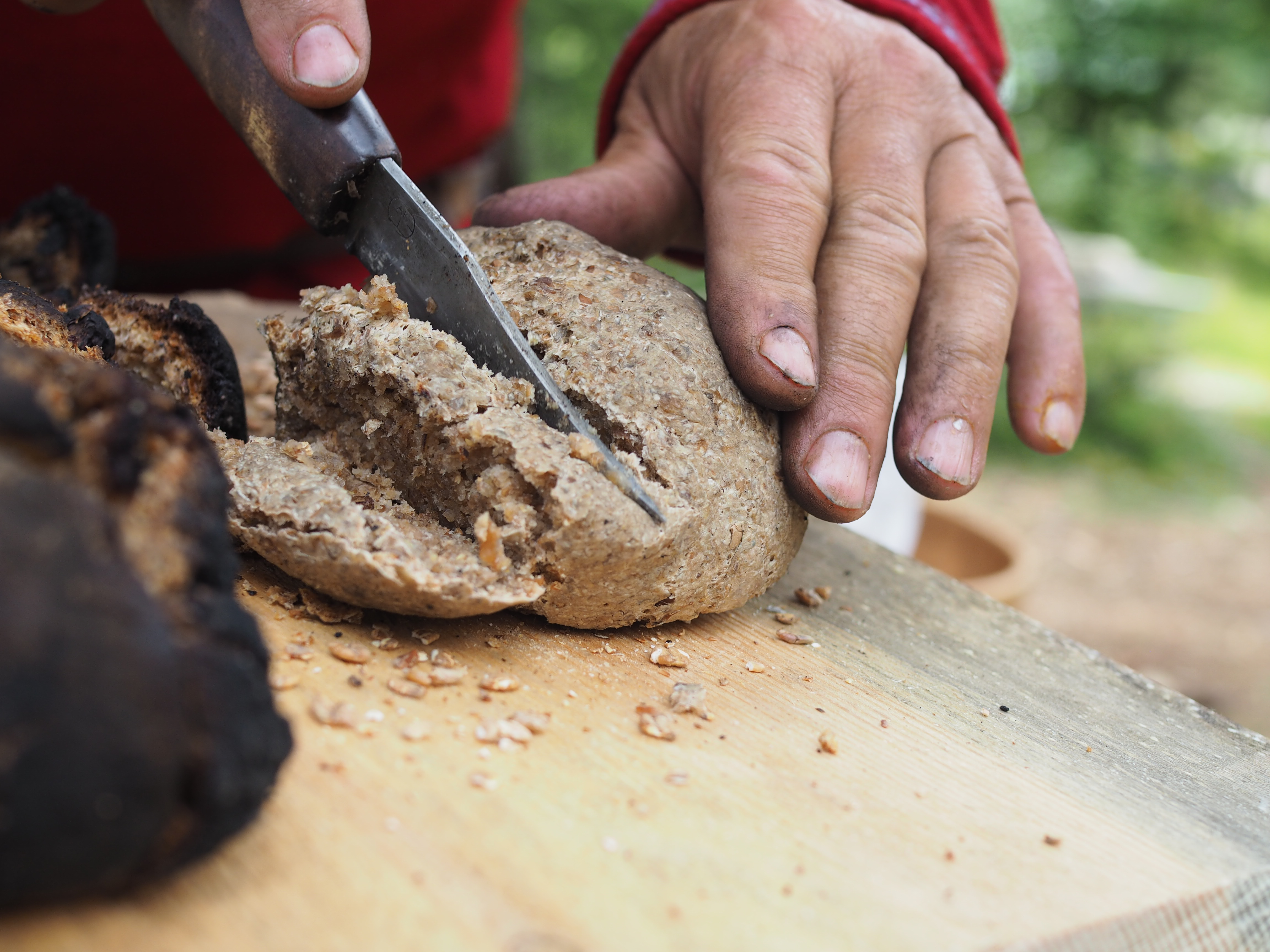

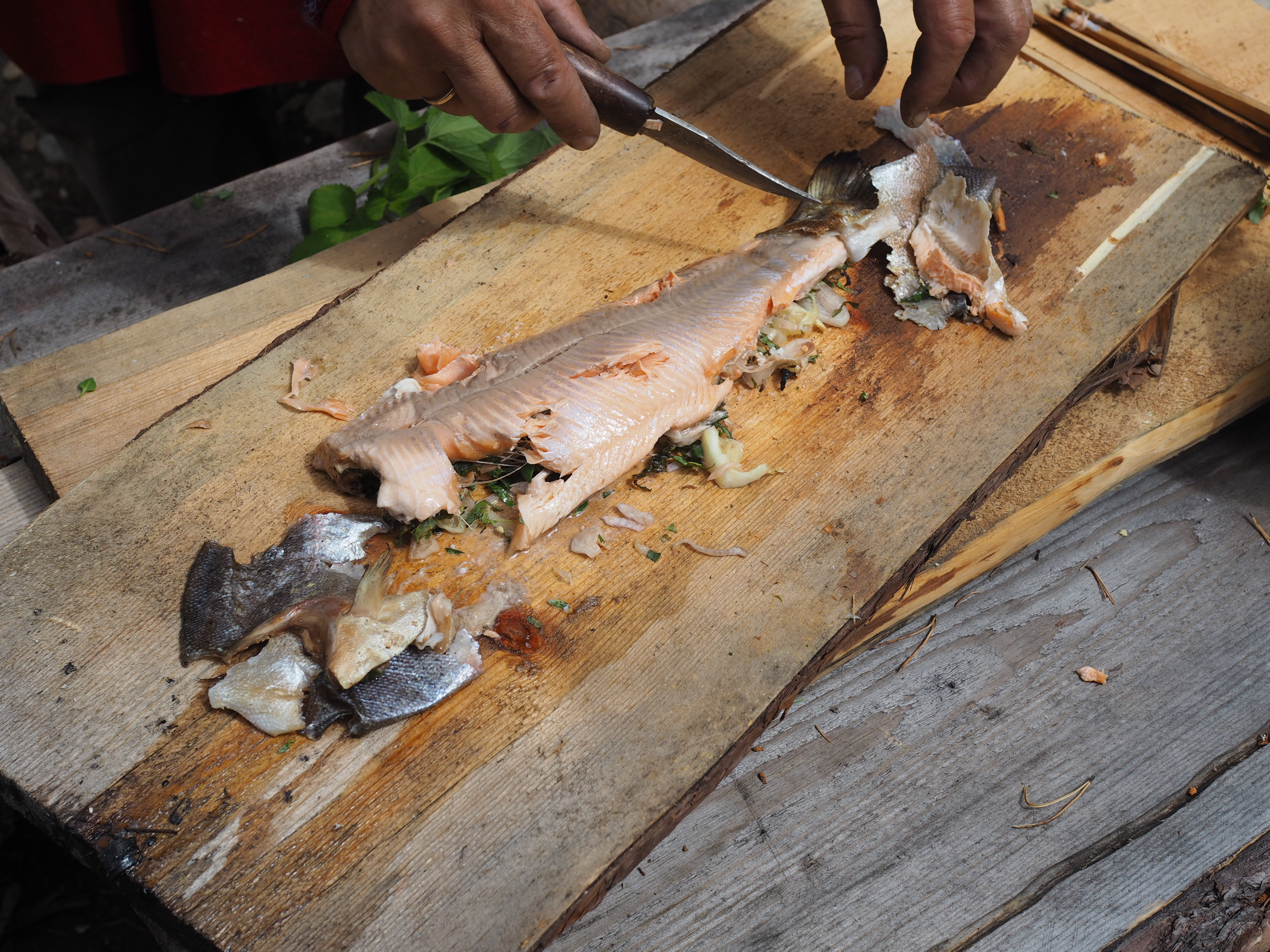
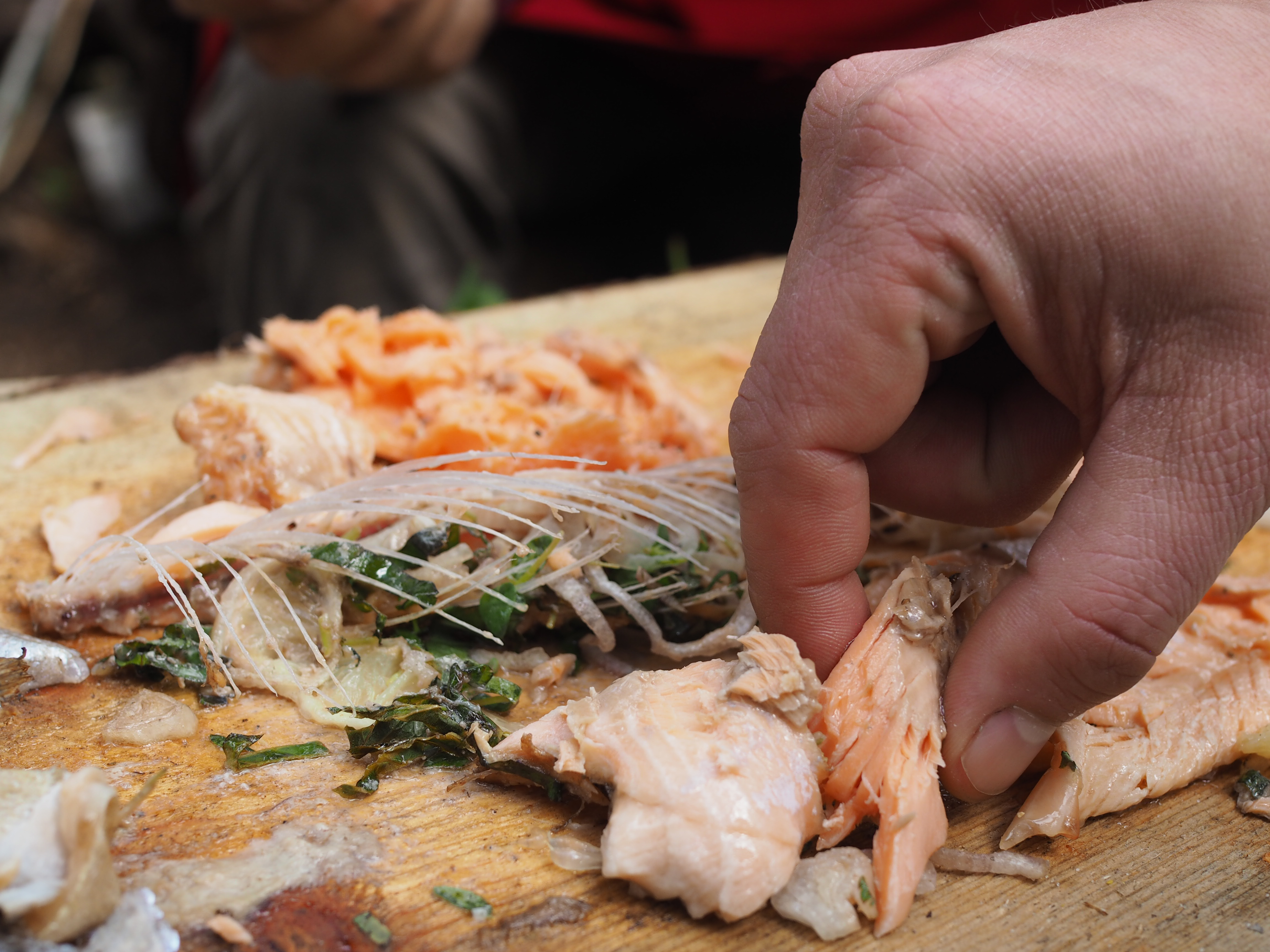
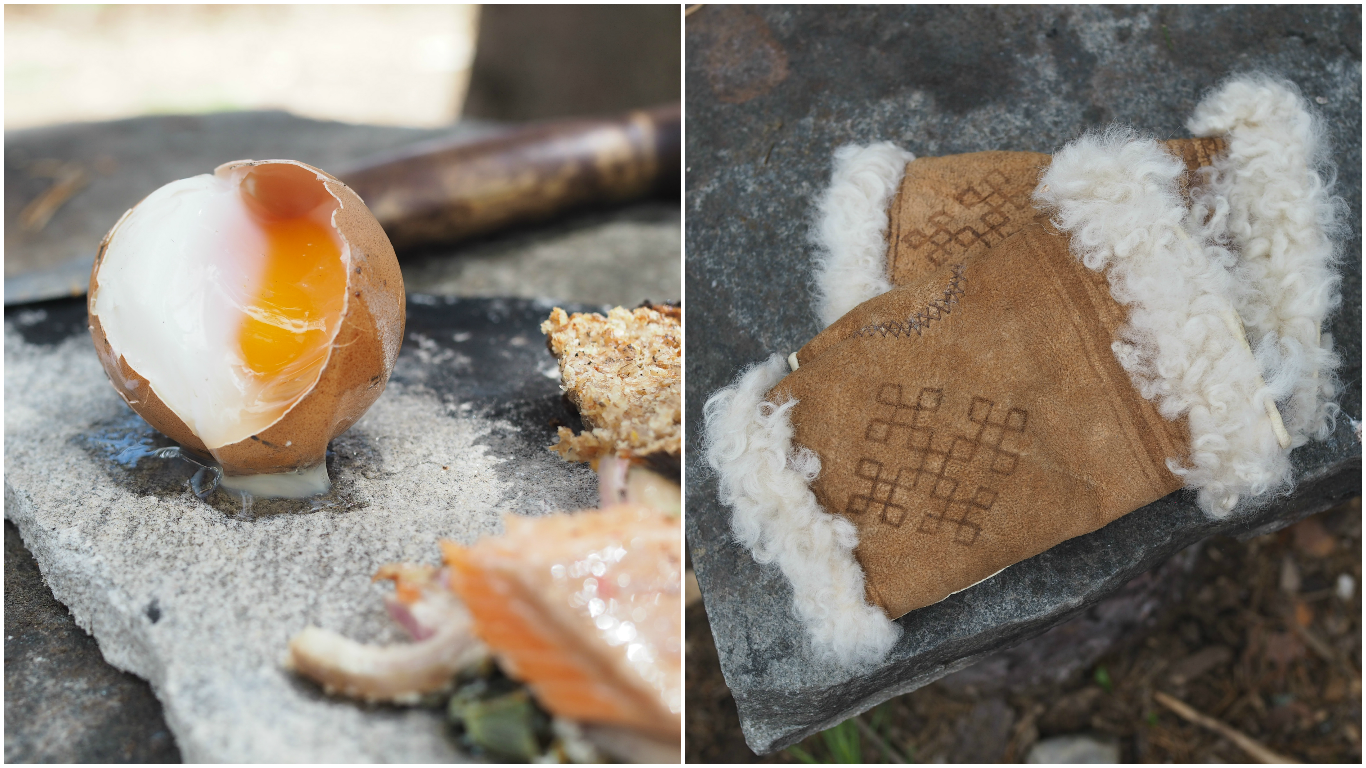
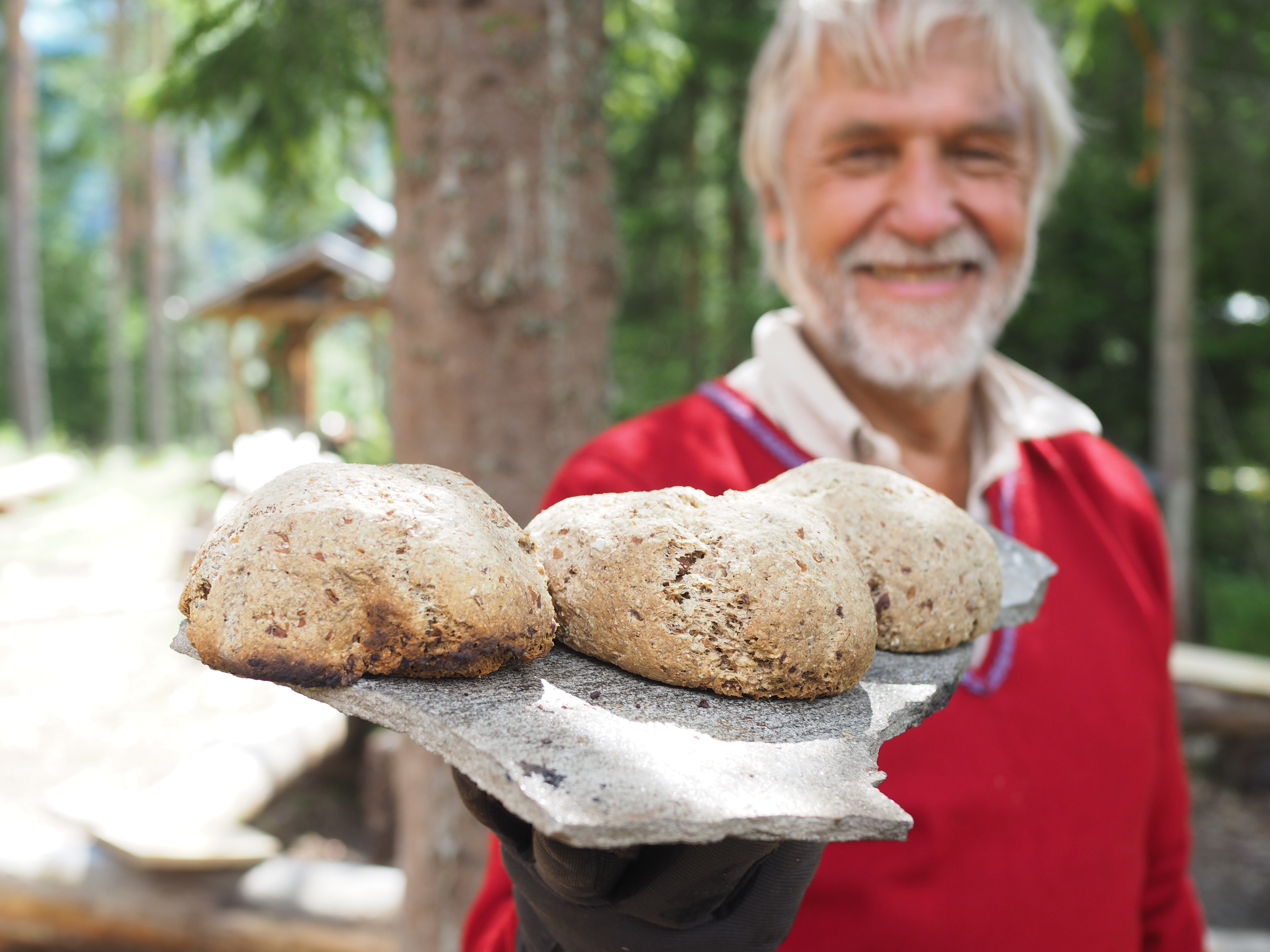 For a truly authentic Viking meal, try recreating this at your next campfire. And if you are in the area of Numedal, be sure to check out the Medieval Week (Middelalderuka), running this year from the 22 July to 30 July 2016. And if you fancy soaring through the waters like a Viking, you can contact kjell@mogen.no at Kreativ Kultur AS (run by Kjell and Maj-Lis) for a ride on their Viking ship.
For a truly authentic Viking meal, try recreating this at your next campfire. And if you are in the area of Numedal, be sure to check out the Medieval Week (Middelalderuka), running this year from the 22 July to 30 July 2016. And if you fancy soaring through the waters like a Viking, you can contact kjell@mogen.no at Kreativ Kultur AS (run by Kjell and Maj-Lis) for a ride on their Viking ship.
Update: The dates for next year’s festival are 24th to 29th July 2017. Visit www.middelalderverkstedet.no.
Plankefisk
Ingredients:
- 1 whole, fresh trout
- 2 shallots, sliced finely
- 1 bunch of thyme
- 1 bunch of ground elder / bishops weed leaves (skvallerkål)
- 1 lemon
- Salt
Prepare two planks of wood for the fish, with a 2-3 cm thickness. Each plank should be at least 20×50 cm, depending on the size of the fish. In the middle of the planks, cut four small holes, where the wooden pegs will hold the fish. These should be measured to the fish (two at the top of the fish, two toward the bottom).
Prepare 8 wooden pegs by removing the bark from wooden branches and whittling them down. The middle of each peg should be slightly thinner than the thickness of a little finger. These need to fit inside the holes in the wooden planks.
Remove the head and insides of the fish, and clean and rinse. Slice the fish in half, lengthways, to get two filets, leaving the skin on.
Dice the shallots and herbs and cut the lemon into small slices. Cover the flesh side of each fish with them. Sprinkle with salt.
Carefully flip over one of the filets onto a wood plank, flesh side down, and attach the fish to the plank with 4 of the wooden pegs – hammering them in the with the back of the knife if necessary. Do the same with the other fish and other plank.
Once fastened, place the planks upright next to the fire. You can use large stones to keep them upright. After about 30 minutes, turn the planks top to bottom for even cooking. The fish is finished when it is soft and the flesh has brightened, around 1 hour total cooking time.
Rugbrød (Rye Bread with Smoked Barley)
Taken from: An Early Meal Cookbook
Starter dough:
- One pinch of fresh yeast (about the size of a pea)
- 3 dl water (∼30 °C)
- 3 dl rye flour
Scalding:
- 2dl smoked barley malt, crushed (normal barley malt if you can’t get smoked)
- 4 dl water (∼66 °C)
Dough:
- 4 dl whey (∼30 °C)
- 6 dl rye flour
- Approx. 12 dl wheat flour
- (Optional 1 Tbs salt)
Starter dough: Dissolve the yeast in water and mix in the flour. The consistency should be like loose porridge. Let it ferment overnight (8-10 hours) in room temperature covered by a linen cloth. When you notice a lot of bubbles on the surface, the starter is ready to use.
Scalding: Let the barley malt steep in heated water, you need to keep the temperature at 60-70°C for about half an hour in order to convert most of the starch to sugar. After about half an hour, raise the temperature to 100°C and let the mixture of malt and sweet liquid boil until the grains are soft and porridgy. Let it rest overnight (about 8-10 hours) in room temperature, covered by a linen cloth.
The dough: Mix the starter, scalded barley, whey, rye flour and salt if you choose to use it. Add the wheat flour little by little in order to achieve the right texture. Work the dough thoroughly by hand, around 10 minutes. Leave it to rise for 3-4 hours in room temperature, covered by a damp linen cloth. When it has doubled in size, it should be finished. If using a modern oven, heat it to 225°C and leave a baking stone or metal baking tray in the oven so it will also be heated. Otherwise, try to get the same temperature in a stone oven, making sure to heat it properly before baking. Divide the dough into 24 pieces, and roll them out into small buns. Roll the buns in some flour. Let them rise for 40 minutes, covered. Cut a cross on the top of the buns with a sharp knife. Put them into the oven, on the hot stone or hot baking tray. Bake until they turn a nice brownish color, 40 minutes. Wrap the baked buns in a linen cloth, and they should keep a few days.
For campfire eggs: gently poke a small hole into each end of an egg with a sharp knife. Take a whittled stick, sharpened at the end, and put it through the holes in the egg. Cook over the fire until set, like you would a marshmallow, being careful to keep the egg horizontal. The shell must be quite strong in order to do this, otherwise the yolk and egg white will run out.
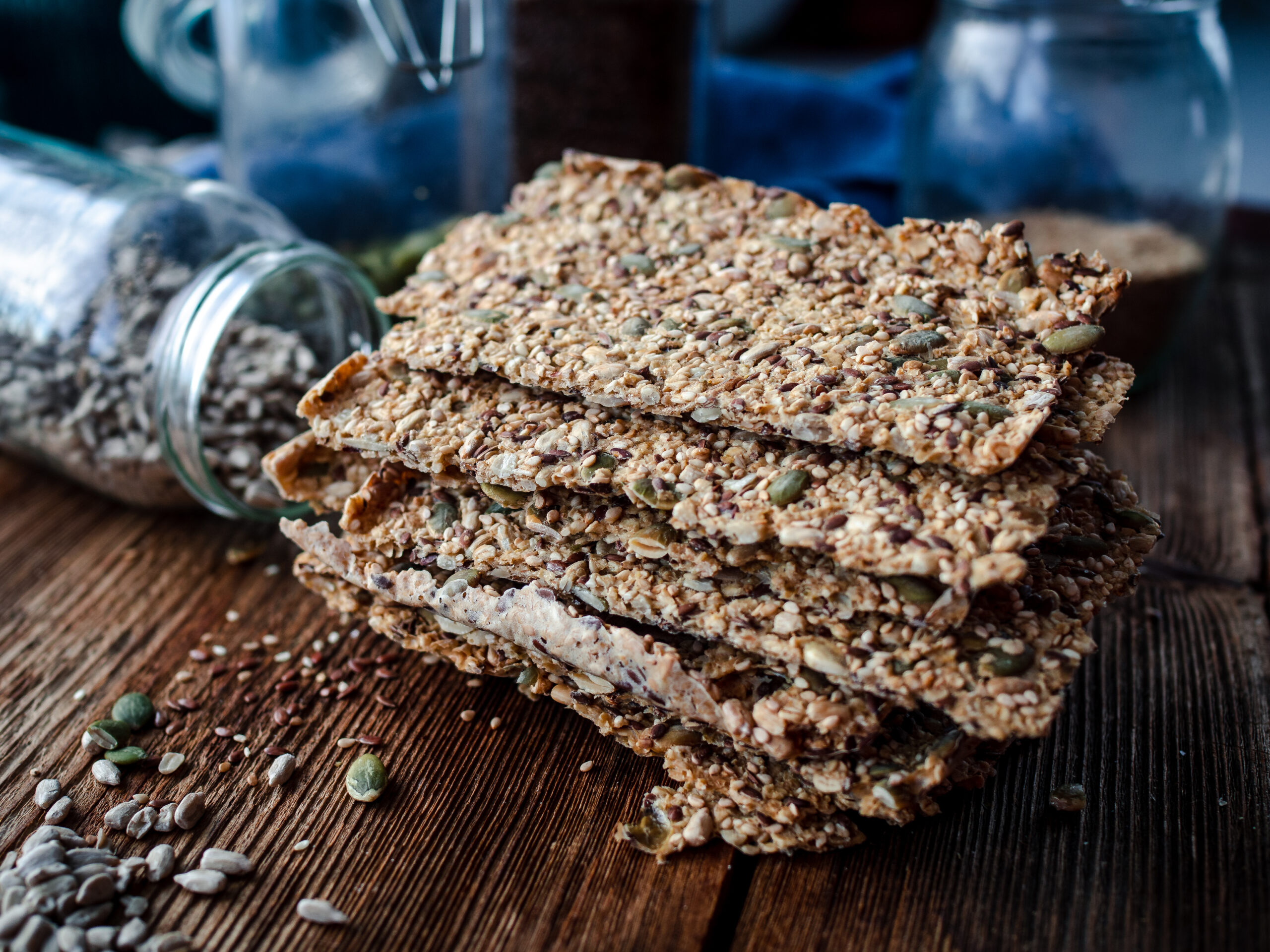
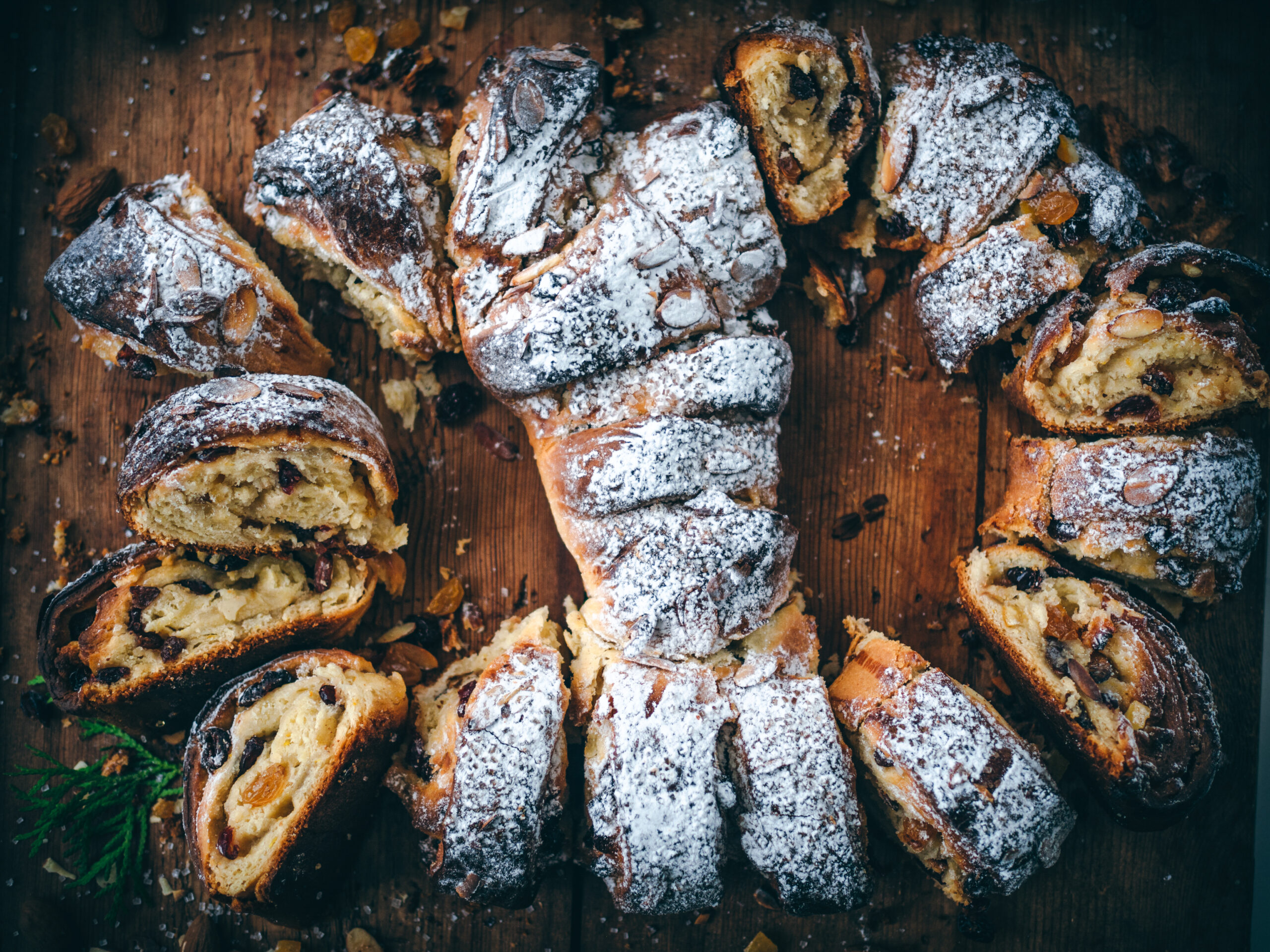
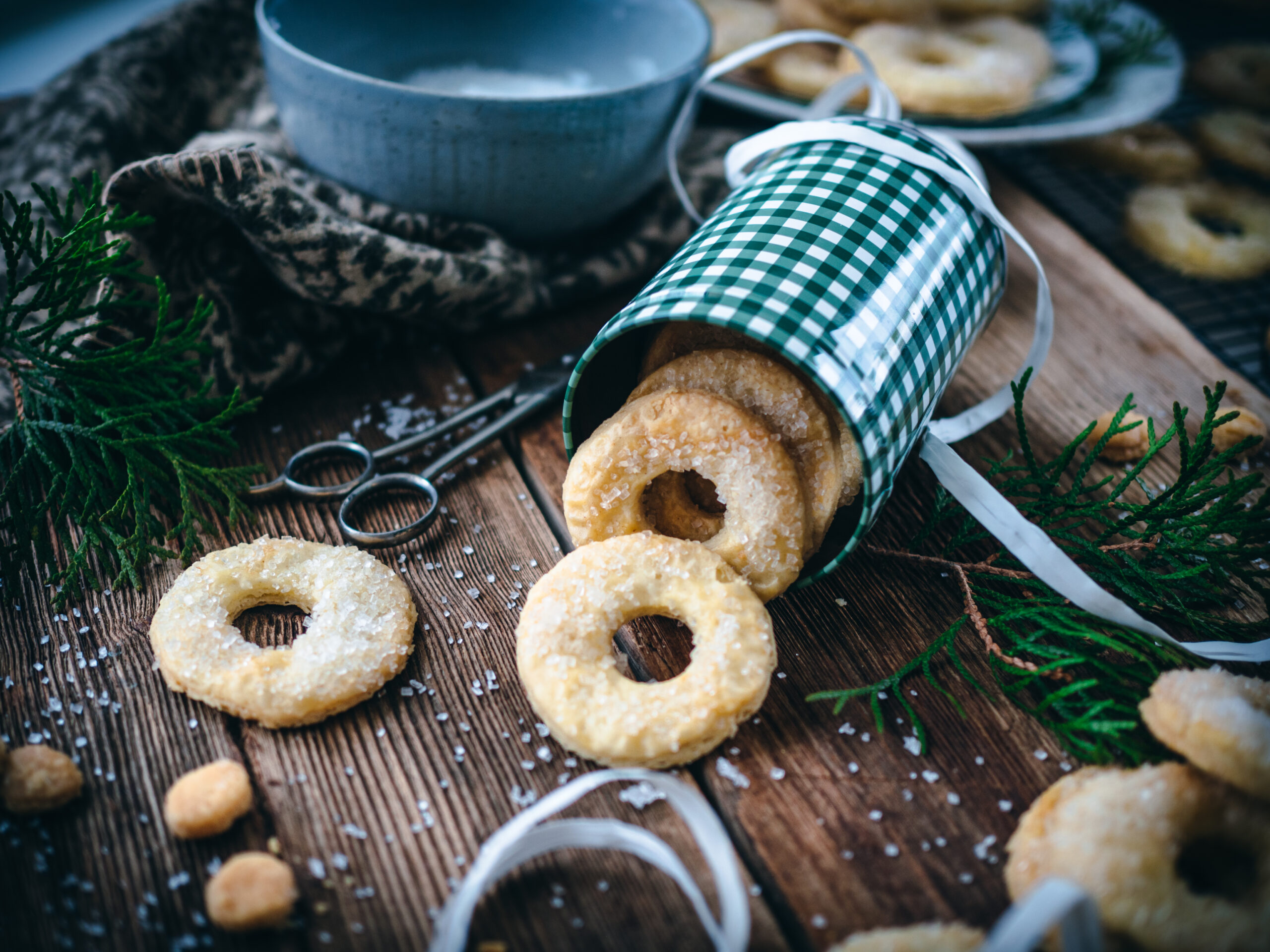
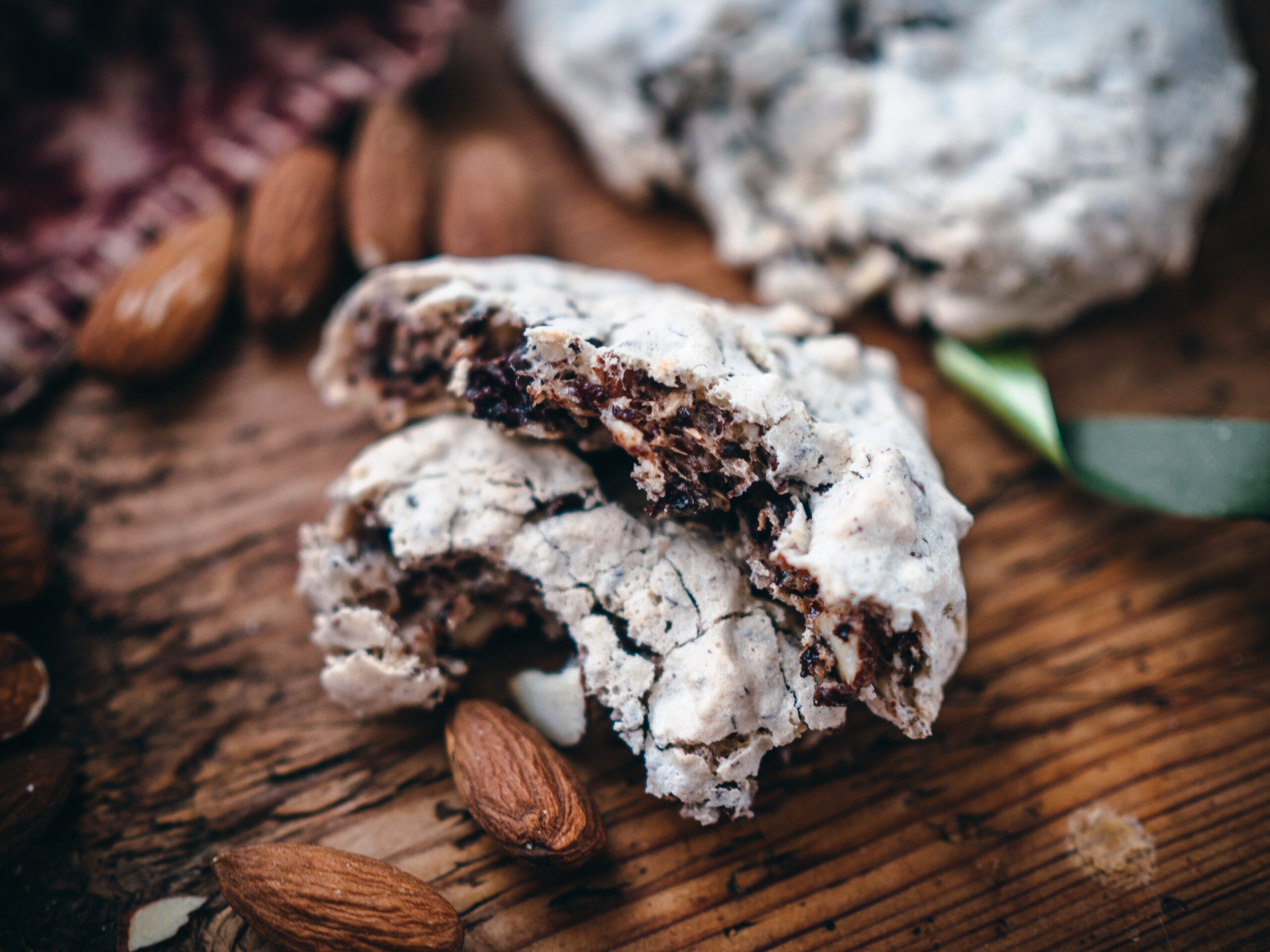

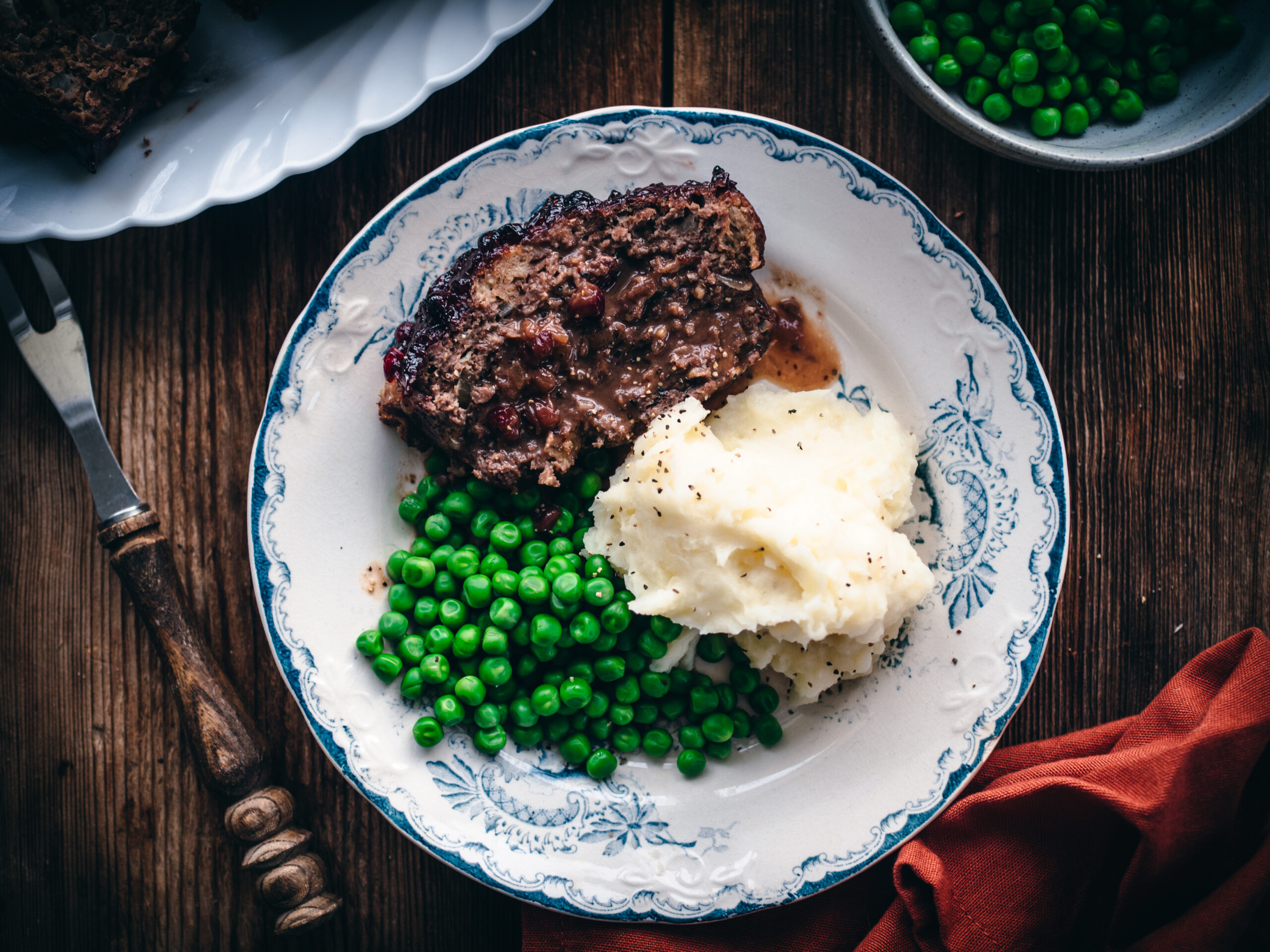
oh my! that looks so deliciously raw and inviting….i can smell the fire and fresh bread…yum
Wowie Zowie! First timer at this site. Wonder recipes, and the photography is stellar. Thanks so much for posting.
Thanks Kevin! So glad you found my site 🙂